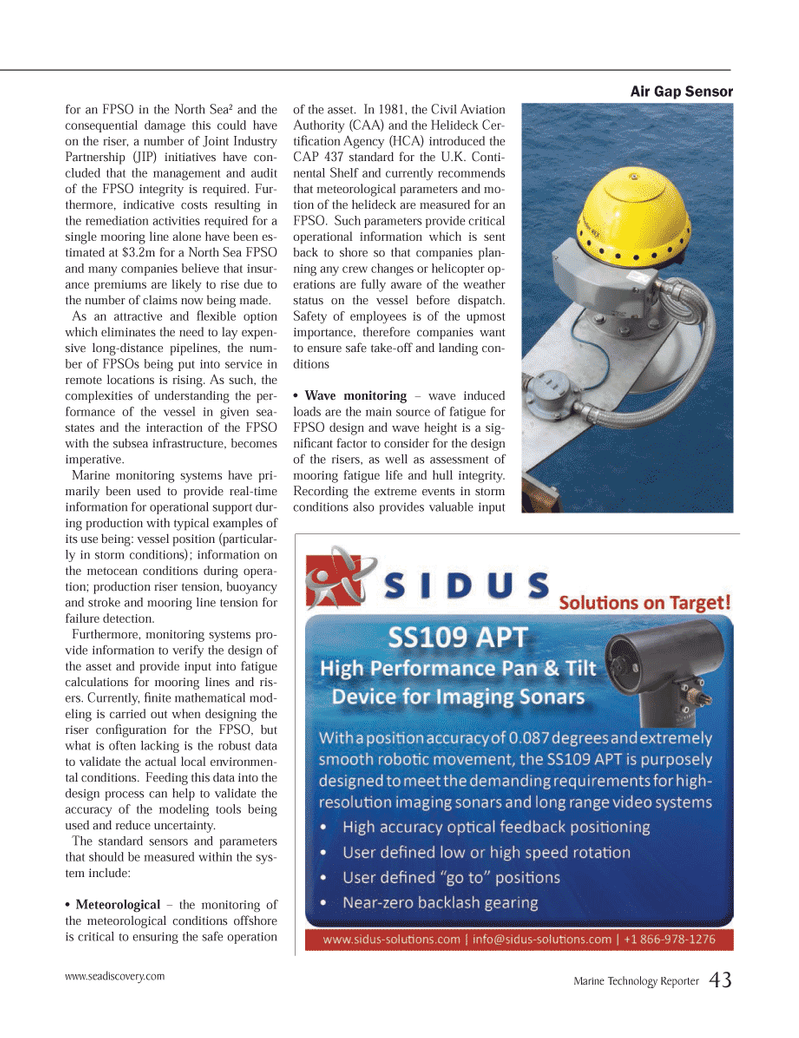
Page 43: of Marine Technology Magazine (November 2013)
Fresh Water Monitoring & Sensors
Read this page in Pdf, Flash or Html5 edition of November 2013 Marine Technology Magazine
for an FPSO in the North Sea² and the consequential damage this could have on the riser, a number of Joint Industry Partnership (JIP) initiatives have con- cluded that the management and audit of the FPSO integrity is required. Fur- thermore, indicative costs resulting in the remediation activities required for a single mooring line alone have been es- timated at $3.2m for a North Sea FPSO and many companies believe that insur- ance premiums are likely to rise due to the number of claims now being made. As an attractive and exible option which eliminates the need to lay expen- sive long-distance pipelines, the num- ber of FPSOs being put into service in remote locations is rising. As such, the complexities of understanding the per- formance of the vessel in given sea- states and the interaction of the FPSO with the subsea infrastructure, becomes imperative. Marine monitoring systems have pri- marily been used to provide real-time information for operational support dur- ing production with typical examples of its use being: vessel position (particular- ly in storm conditions); information on the metocean conditions during opera-tion; production riser tension, buoyancy and stroke and mooring line tension for failure detection. Furthermore, monitoring systems pro-vide information to verify the design of the asset and provide input into fatigue calculations for mooring lines and ris-ers. Currently, nite mathematical mod- eling is carried out when designing the riser con guration for the FPSO, but what is often lacking is the robust data to validate the actual local environmen- tal conditions. Feeding this data into the design process can help to validate the accuracy of the modeling tools being used and reduce uncertainty. The standard sensors and parameters that should be measured within the sys-tem include: Meteorological ? the monitoring of the meteorological conditions offshore is critical to ensuring the safe operation of the asset. In 1981, the Civil Aviation Authority (CAA) and the Helideck Cer- ti cation Agency (HCA) introduced the CAP 437 standard for the U.K. Conti-nental Shelf and currently recommends that meteorological parameters and mo-tion of the helideck are measured for an FPSO. Such parameters provide critical operational information which is sent back to shore so that companies plan-ning any crew changes or helicopter op- erations are fully aware of the weather status on the vessel before dispatch. Safety of employees is of the upmost importance, therefore companies want to ensure safe take-off and landing con- ditions Wave monitoring ? wave induced loads are the main source of fatigue for FPSO design and wave height is a sig- ni cant factor to consider for the design of the risers, as well as assessment of mooring fatigue life and hull integrity. Recording the extreme events in storm conditions also provides valuable input Air Gap Sensorwww.seadiscovery.com Marine Technology Reporter 43MTR #9 (34-49).indd 43MTR #9 (34-49).indd 4312/13/2013 9:35:28 AM12/13/2013 9:35:28 AM

 42
42

 44
44
